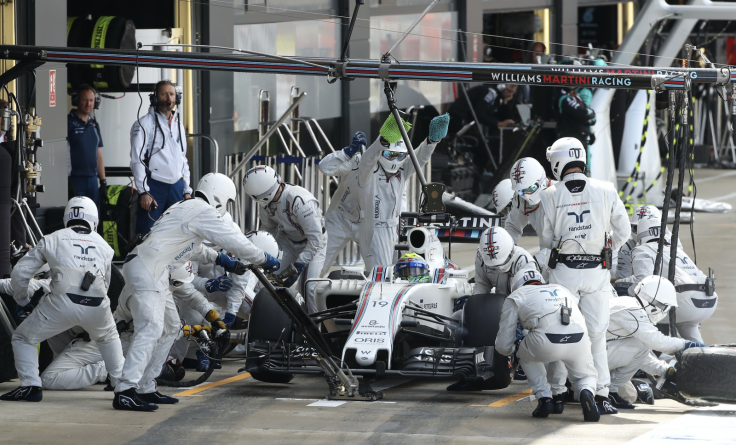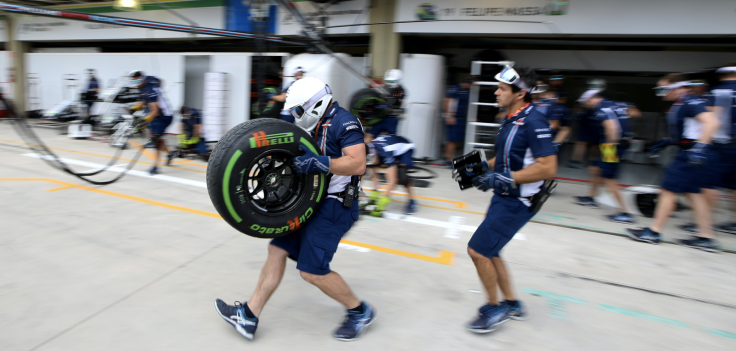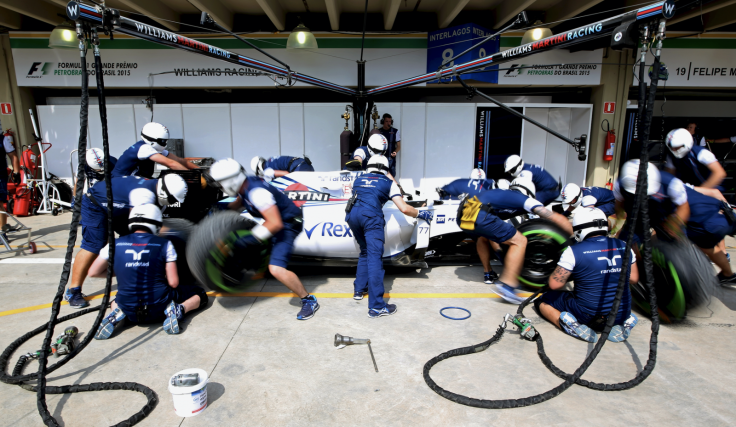How bio technology helps Formula One perform record-breaking pitstops
F1 team reveals how three years of hard work with wearables and biotech shaved 0.6 seconds from a pitstop.

1.92 seconds. That's how long it took the Williams Formula One team to perform a pitstop and change four tyres during the 2016 European Grand Prix.
It is currently the fastest stop ever seen at an F1 race and, although over in the blink of an eye, getting from a sedate 3.5 seconds to here took three years of hard work, the invention of new wearable biometric monitors, advanced choreography and thousands of practices per season.
Back in 2013, Williams were performing some of the slowest pit stops on the grid. Changing four wheels in 3.5 seconds might sound impressive, but the team was losing precious time whenever a driver stopped for new tyres. In F1 this is a huge disadvantage and one Williams wanted to overcome.
Step forward biometric technology, big data and cloud computing.
The team realised that, while the car was covered in 300 sensors producing 60GB of data per race weekend, the mechanics were barely monitored at all. Where every aspect of the car is recorded, logged and analysed in minute detail to cut lap times by hundredths of a second, the pit crew changed tyres without a second thought; if something went wrong, it went wrong. There was no system in place to analyse what happened, find out why and make sure it didn't happen again.
To fix this and return the team to winning ways, Williams hired Gemma Fisher to take up the newly created role of human performance specialist. If the pit crew are a team within a team, Fisher is their head coach employed to help them perform better, both mentally and physically.
Speaking to journalists at the Williams factory, Fisher explained: "With a race calendar as demanding as 21 races and five tests, long-haul flights and 18-hour days, it's quite a challenge, it's very physical. And unlike any other forms of racing, like Nascar where you have professional pit crews, the guys performing [F1] stops are also the mechanics. They are fatigued, overworked and not always at peak physical status, so we had to find a way to motivate them to perform sub-two second pitstops."
Keeping a cool head
Both at the Williams factory in Oxfordshire and at each of the race weekends, the pit crew are subjected to ongoing mental and psychological training to help them deal with the demands of performing stops quickly and keeping a cool head when something goes wrong. As with other teams, the Williams crew are contractually obliged to visit the gym several times a week.

Each stop during the race is recorded by three cameras and the footage is monitored by Fisher to make sure each team member did their job quickly and correctly. Extra GoPro cameras are added to the team's helmets during practice, but these are forbidden on race day.
From here she can suggest changes to their stance or the way they hold the new tyres. Fisher even looks at the route mechanics take from their seat in the garage to the pit lane to make sure there are no obstacles to momentarily distract them from the stop. Every step and movement is choreographed to be as simple and efficient as possible.
Wearable tech
The pit crew wear fitness trackers around their chests to record heart rate, breathing rate, movement and stress levels. Data captured here is uploaded to a Microsoft cloud server and analysed by IT company Avanade. It is then presented back to Williams as part of a digital dashboard which helps Fisher and her crew make sense of it. Spikes in heart rate and stress levels (which are often followed by a slow stop) indicate where changes need to be made.
At the factory Williams has created a testing rig which simulates how a wheel approaches each member of the pit crew during a stop. An hydraulic system slides a wheel hub with race tyre attached 20 feet across a room to where three mechanics (wheel on, wheel off and gun man) are waiting to make the change. The rig, which we were not allowed to photograph, can be set up to individually test each of the four teams responsible for each wheel. A computer adjusts the speed the rig moves and exactly where it stops, simulating the times when a driver arrives too fast and misses their mark, forcing the entire crew to move.
On top of this, the Williams crew perform around 2,000 practice pit stops each season, both during race weekends and in the factory car park.
"You can essentially win or lose a race in a pitstop," Fisher continues. "The crew need to be physically capable, but also be able to deal with the stress and the pressure of knowing any mistakes made in the pitstop could cost you the race; it's a lot of pressure to deal with, and also knowing the eyes of the world's media are on you."

The sub-one-second stop
Speaking later to IBTimes UK, Fisher explains: "Three years ago we didn't really know what the potential could be. At the time we would have been over the moon with a three-second stop and laughed you out of the room for suggesting sub-two seconds. But less than a year later that's what we're pushing for...can it be sub-one second is always the next question."
Williams dipped below the two-second mark for the first time in 2016, performing a 1.92 second tyre change at the European Grand Prix at Baku circuit in Azerbaijan, setting a new world record. In practice (on a stationary car with no driver) the team can get their time down to just 1.25 seconds.
Looking ahead to 2017, Fisher says the larger and heavier tyres being introduced to Formula One will be "a huge obstacle". They are expected to be around 2.5kg heavier, but manufacturer Pirelli is yet to confirm this to the teams, who are for now forced to practice with mock-ups.
Fisher explains how pitstops are analysed and improved every race: "After the race, when we've got the data and the videos and gone through every element of the pitstop, we then look at all of the events which have led up to and potentially caused an error. It happens in such a short amount of time but there are so many different factors that could have caused it, and at the time they don't even know...at the next race we have a debrief together, watch the videos, run through the data and look at what we need to do to avoid an error happening again."
Tip of the technological iceberg
Asked about what comes next, Fisher believes Williams are only just touching the surface of what is possible with pit crews, biometrics and wearable technology.
"With this we really are only touching the surface, it really is the tip of the iceberg. We'll be analysing the data over the winter and start to see trends and understand the physiology behind a good stop versus a bad stop...Wearable technology is an avenue we will focus on exploring even more so."
© Copyright IBTimes 2025. All rights reserved.






















